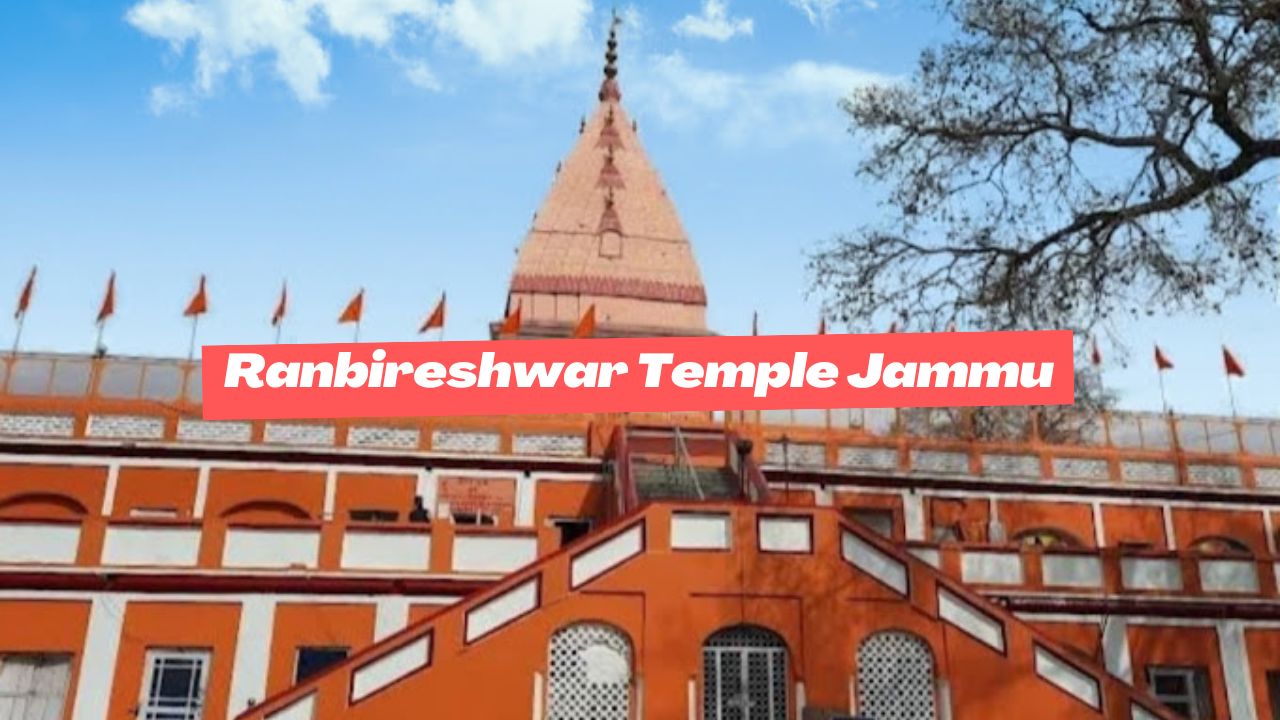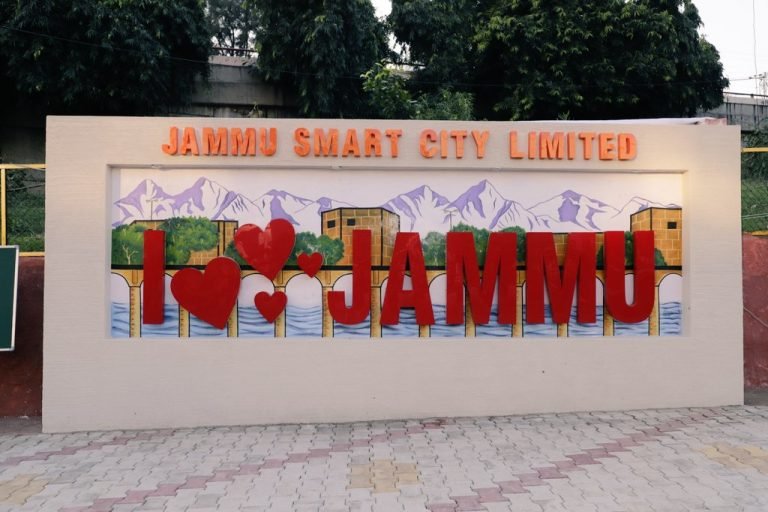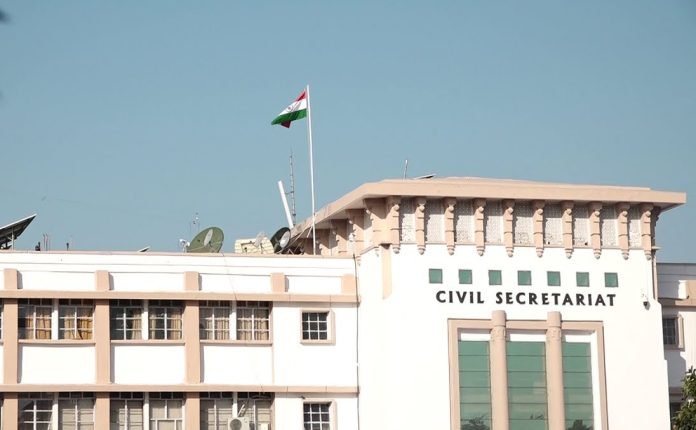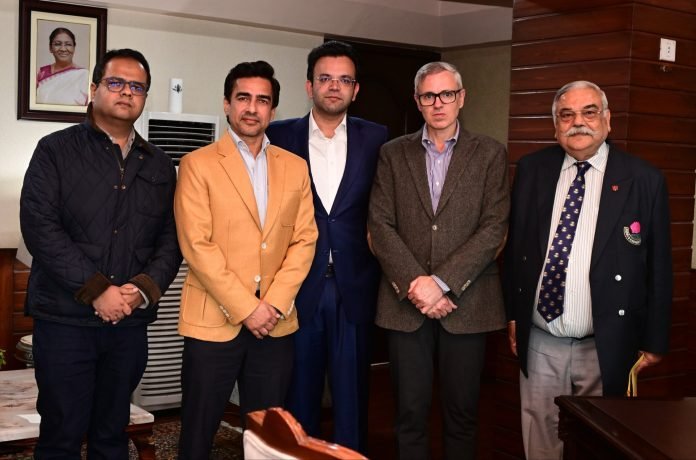Nestled in the vibrant city of Jammu, the Ranbireshwar Temple Jammu stands as a testament to architectural splendor and deep spiritual significance. Dedicated to Lord Shiva, this temple is a must-visit destination for devotees and tourists alike.
Historical Significance of Ranbireshwar Temple Jammu
Constructed under the reign of Maharaja Ranbir Singh (1857–1885), the temple reflects the Dogra ruler’s vision of transforming Jammu into a spiritual hub, akin to Kashi (Varanasi). The temple’s name, “Ranbireshwar,” combines the Maharaja’s name with “Ishwar,” signifying Lord Ranbir. The temple’s structure is a harmonious blend of devotion and artistry, with the main temple situated on the first floor, accessible through a grand staircase.
A notable feature is the statue of Maharaja Ranbir Singh installed in the temple courtyard, depicting the ruler in a prayerful stance before Lord Shiva. While this statue was added decades after the temple’s construction, it serves as a poignant reminder of the Maharaja’s dedication to promoting Hindu culture and spirituality.
Architectural Grandeur and Unique Features
The Ranbireshwar Temple is home to India’s one of largest lingam, an 8-foot-tall black stone marvel that dominates the temple’s sanctum. Accompanying the main lingam are 12 crystal shivlings of varying sizes, ranging from 15 to 38 centimeters, along with over 125,000 miniature lingams (bona lingams) brought from the sacred Narmada River. These are meticulously displayed on stone slabs, creating an awe-inspiring visual.
The Ranbireshwar Temple, built on an elevated hillock, features a unique design where the sanctum sanctorum is perched on the top floor, symbolizing a closer connection to the divine.
Adding to its uniqueness are the life-sized idols of Lord Ganesha, Kartikeya, and the iconic brass statue of Nandi Bull, which guards the entrance to the sanctum. Visitors are also drawn to the Ekadash Lingams, crafted from a rare transparent white stone known as safatik, specially sourced from Varanasi. These exquisite artifacts make the Ranbireshwar Temple a rare treasure among Shiva temples.
A colossal brass Nandi guards the entrance, while a huge monumental metallic bell nn one side of Nandi, which weighs over a quintal ( over 100 kg) resonates with the chants of worshippers. The site also commemorates a saint who once meditated here, with his samadhi preserved beneath the temple grounds.
The temple also boasts rare Ekadash Lingams crafted from Sphatik, a translucent gemstone, and sacred shaligrams sourced from the Narmada River, revered by Shiva worshippers.
Ranbireshwar Temple Jammu is a Spiritual Haven for Devotees
The Ranbireshwar Temple offers ample space for meditation and prayer, a rarity among many temples. The tranquil ambiance is complemented by a large metallic bell weighing over 100 kilograms, adding to the temple’s spiritual aura. The temple grounds also house smaller shrines dedicated to Mahakali, Lord Hanuman, Shani Dev, and Lord Kartikeya, further enriching the devotional experience.

During the holy month of Sawan, thousands of devotees throng the temple to offer prayers to Lord Shiva. The chants of “Om Namah Shivaya” and “Bam Bam Bhole” resonate throughout the premises, creating an electrifying spiritual atmosphere. Maha Shivratri is celebrated with grandeur, attracting devotees from across the region to participate in communal prayers and festivities.
Yasho-Karn Park: A Tribute to Legacy
Behind the temple lies Yasho-Karn Park, inaugurated in 2012 by Dr. Karan Singh in memory of Maharani Yasho Rajya Lakshmi. This verdant oasis enhances the temple’s allure, inviting both pilgrims and tourists to immerse in tranquility.
Vibrant Festivals and Devotional Splendor
Ranbireshwar Temple becomes a spiritual epicenter during Maha Shivratri and the auspicious month of Sawan, attracting throngs of devotees. The air reverberates with chants of “Om Namo Shivaya” and “Bam Bam Bhole,” creating an electrifying atmosphere. The temple, adorned with lights and flowers, serves as a haven for collective prayer and spiritual unity.
Tourist Attractions Near Ranbireshwar Temple Jammu
- Peer Mitha Shrine: A revered Muslim shrine, Peer Mitha is known for its unique tradition of accepting only sugar as an offering. Located in central Jammu, it symbolizes harmony and spiritual devotion.
- Mubarak Mandi Palace: Once the royal residence of the Dogra dynasty, this historic palace overlooks the Tawi River and showcases exquisite architectural beauty. It is also home to the renowned Dogra Art Museum, a treasure trove of cultural and historical artifacts from the region.
- Raghunath Temple: Renowned as one of the largest temple complexes in northern India, Raghunath Temple is a major pilgrimage site in Jammu.
- Peer Kho Temple: A cave temple dedicated to Lord Shiva, Peer Kho is associated with the legendary Jogi Guru Garib Nath and offers a serene retreat for meditation.
- Old City Walk: Explore the bustling streets of Raghunath Bazaar and Purani Mandi, where you can savor traditional delicacies and shop for local handicrafts.
Best Time to Visit Ranbireshwar Temple
The ideal time to visit the Ranbireshwar Temple is between October and March when the weather is pleasant. Major festivals like Maha Shivratri (February-March) and Navratri (September-October) add vibrancy to the temple’s spiritual environment, offering visitors a deeply enriching experience.
Pilgrimage Experience at Ranbireshwar Temple
A visit to the Ranbireshwar Temple is more than a spiritual journey; it is an experience of peace and devotion. The serene atmosphere, coupled with the resonating chants and rituals, fosters a sense of connection with the divine. Devotees often offer milk, flowers, and fruits to the Shiva Lingams while participating in collective prayers during festivals.
Read also: Information About Bawe Wali Mata Jammu
During Maha Shivratri, the temple is adorned with intricate decorations, and the energy of the crowd enhances the devotional experience. Visitors leave the temple with a sense of spiritual fulfillment and a deeper connection to Lord Shiva.
How to Reach Ranbireshwar Temple Jammu
It is located on Shalimar Road, near the New Secretariat, and remains a key highlight of Jammu, often referred to as the “City of Temples.” The temple is situated in a central area, making it accessible by car. There are parking facilities nearby for visitors.
To reach Ranbireshwar Temple in Jammu, follow these guidelines:
- From Jammu Airport (Satwari Airport) is approximately 7 km away from the temple.
- From Jammu Tawi Railway Station, located about 3 km from the temple.
Follow below Map to reach Ranbireshwar Temple Jammu
No matter where you are in Jammu city, reaching Ranbireshwar Temple is convenient. The city offers a well-connected private transport network, including buses, taxis, and auto-rickshaws, with frequent services to major locations. Local buses and state transport options are also available, providing easy access to the temple.
Read also: Best Shopping Places in Jammu City
The Ranbireshwar Temple Jammu is not just a place of worship; it is a cultural landmark that underscores Jammu’s legacy as the “City of Temples.” Its architectural magnificence, spiritual significance, and serene ambiance make it a must-visit destination for anyone exploring the region.
Whether you are a devotee seeking blessings or a tourist admiring heritage, the Ranbireshwar Temple offers an unforgettable experience steeped in spirituality and history. Plan your visit to this iconic temple and immerse yourself in the divine energy that defines Jammu’s rich cultural fabric.
















